Junsheng Jin
Towards Reliable Advertising Image Generation Using Human Feedback
Aug 01, 2024



Abstract:In the e-commerce realm, compelling advertising images are pivotal for attracting customer attention. While generative models automate image generation, they often produce substandard images that may mislead customers and require significant labor costs to inspect. This paper delves into increasing the rate of available generated images. We first introduce a multi-modal Reliable Feedback Network (RFNet) to automatically inspect the generated images. Combining the RFNet into a recurrent process, Recurrent Generation, results in a higher number of available advertising images. To further enhance production efficiency, we fine-tune diffusion models with an innovative Consistent Condition regularization utilizing the feedback from RFNet (RFFT). This results in a remarkable increase in the available rate of generated images, reducing the number of attempts in Recurrent Generation, and providing a highly efficient production process without sacrificing visual appeal. We also construct a Reliable Feedback 1 Million (RF1M) dataset which comprises over one million generated advertising images annotated by human, which helps to train RFNet to accurately assess the availability of generated images and faithfully reflect the human feedback. Generally speaking, our approach offers a reliable solution for advertising image generation.
A Pre-Computing Solution for Online Advertising Serving
Jul 04, 2022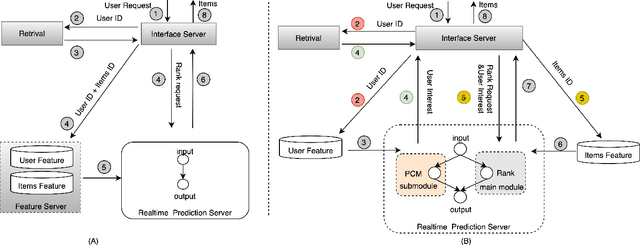

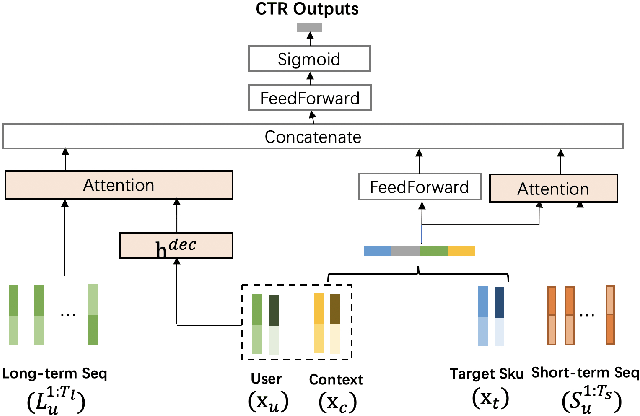
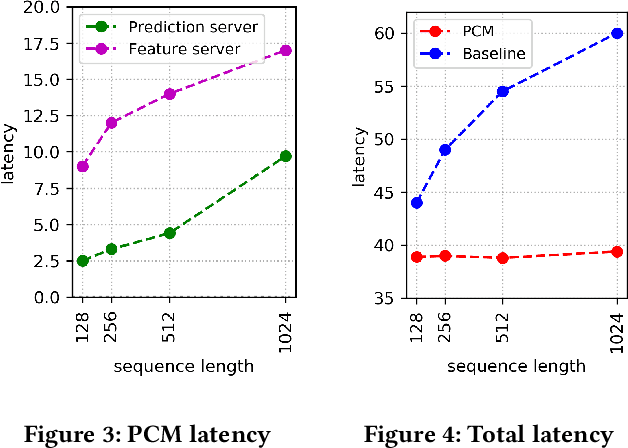
Abstract:Click-Through Rate (CTR) prediction plays a key role in online advertising systems and online advertising. Constrained by strict requirements on online inference efficiency, it is often difficult to deploy useful but computationally intensive modules such as long-term behaviors modeling. Most recent works attempt to mitigate the online calculation issue of long historical behaviors by adopting two-stage methods to balance online efficiency and effectiveness. However, the information gaps caused by two-stage modeling may result in a diminished performance gain. In this work, we propose a novel framework called PCM to address this challenge in the view of system deployment. By deploying a pre-computing sub-module parallel to the retrieval stage, our PCM effectively reduces overall inference time which enables complex modeling in the ranking stage. Comprehensive offline and online experiments are conducted on the long-term user behaviors module to validate the effectiveness of our solution for the complex models. Moreover, our framework has been deployed into a large-scale real-world E-commerce system serving the main interface of hundreds of millions of active users, by deploying long sequential user behavior model in PCM. We achieved a 3\% CTR gain, with almost no increase in the ranking latency, compared to the base framework demonstrated from the online A/B test. To our knowledge, we are the first to propose an end-to-end solution for online training and deployment on complex CTR models from the system framework side.
IA-GCN: Interactive Graph Convolutional Network for Recommendation
Apr 08, 2022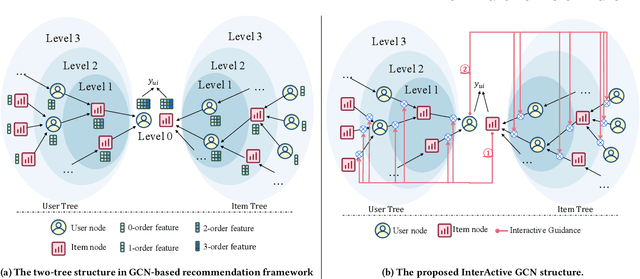
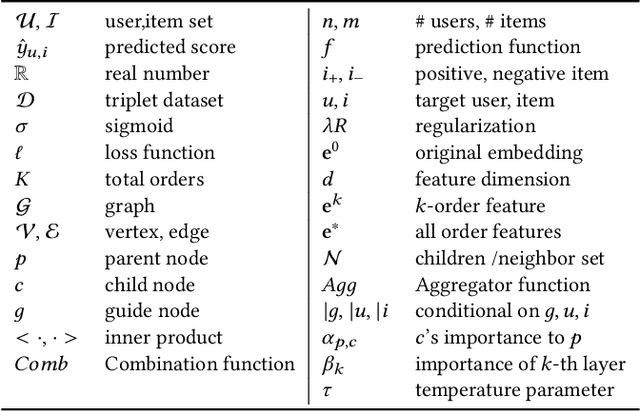

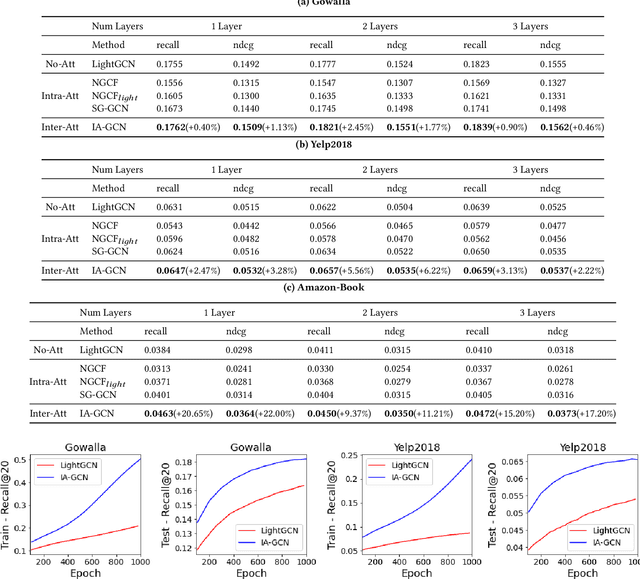
Abstract:Recently, Graph Convolutional Network (GCN) has become a novel state-of-art for Collaborative Filtering (CF) based Recommender Systems (RS). It is a common practice to learn informative user and item representations by performing embedding propagation on a user-item bipartite graph, and then provide the users with personalized item suggestions based on the representations. Despite effectiveness, existing algorithms neglect precious interactive features between user-item pairs in the embedding process. When predicting a user's preference for different items, they still aggregate the user tree in the same way, without emphasizing target-related information in the user neighborhood. Such a uniform aggregation scheme easily leads to suboptimal user and item representations, limiting the model expressiveness to some extent. In this work, we address this problem by building bilateral interactive guidance between each user-item pair and proposing a new model named IA-GCN (short for InterActive GCN). Specifically, when learning the user representation from its neighborhood, we assign higher attention weights to those neighbors similar to the target item. Correspondingly, when learning the item representation, we pay more attention to those neighbors resembling the target user. This leads to interactive and interpretable features, effectively distilling target-specific information through each graph convolutional operation. Our model is built on top of LightGCN, a state-of-the-art GCN model for CF, and can be combined with various GCN-based CF architectures in an end-to-end fashion. Extensive experiments on three benchmark datasets demonstrate the effectiveness and robustness of IA-GCN.
Dynamic Parameterized Network for CTR Prediction
Nov 09, 2021
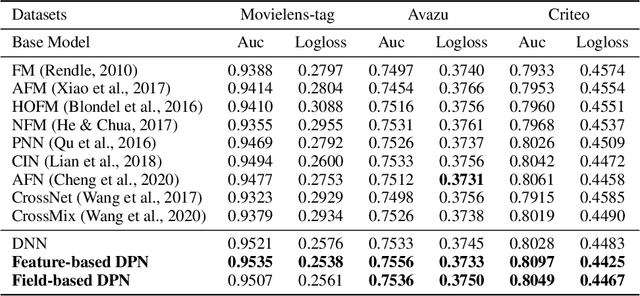


Abstract:Learning to capture feature relations effectively and efficiently is essential in click-through rate (CTR) prediction of modern recommendation systems. Most existing CTR prediction methods model such relations either through tedious manually-designed low-order interactions or through inflexible and inefficient high-order interactions, which both require extra DNN modules for implicit interaction modeling. In this paper, we proposed a novel plug-in operation, Dynamic Parameterized Operation (DPO), to learn both explicit and implicit interaction instance-wisely. We showed that the introduction of DPO into DNN modules and Attention modules can respectively benefit two main tasks in CTR prediction, enhancing the adaptiveness of feature-based modeling and improving user behavior modeling with the instance-wise locality. Our Dynamic Parameterized Networks significantly outperforms state-of-the-art methods in the offline experiments on the public dataset and real-world production dataset, together with an online A/B test. Furthermore, the proposed Dynamic Parameterized Networks has been deployed in the ranking system of one of the world's largest e-commerce companies, serving the main traffic of hundreds of millions of active users.
Kalman Filtering Attention for User Behavior Modeling in CTR Prediction
Oct 20, 2020



Abstract:Click-through rate (CTR) prediction is one of the fundamental tasks for e-commerce search engines. As search becomes more personalized, it is necessary to capture the user interest from rich behavior data. Existing user behavior modeling algorithms develop different attention mechanisms to emphasize query-relevant behaviors and suppress irrelevant ones. Despite being extensively studied, these attentions still suffer from two limitations. First, conventional attentions mostly limit the attention field only to a single user's behaviors, which is not suitable in e-commerce where users often hunt for new demands that are irrelevant to any historical behaviors. Second, these attentions are usually biased towards frequent behaviors, which is unreasonable since high frequency does not necessarily indicate great importance. To tackle the two limitations, we propose a novel attention mechanism, termed Kalman Filtering Attention (KFAtt), that considers the weighted pooling in attention as a maximum a posteriori (MAP) estimation. By incorporating a priori, KFAtt resorts to global statistics when few user behaviors are relevant. Moreover, a frequency capping mechanism is incorporated to correct the bias towards frequent behaviors. Offline experiments on both benchmark and a 10 billion scale real production dataset, together with an Online A/B test, show that KFAtt outperforms all compared state-of-the-arts. KFAtt has been deployed in the ranking system of a leading e commerce website, serving the main traffic of hundreds of millions of active users everyday.
 Add to Chrome
Add to Chrome Add to Firefox
Add to Firefox Add to Edge
Add to Edge